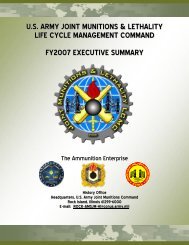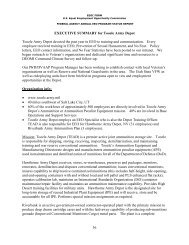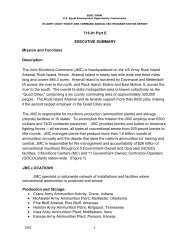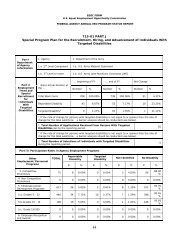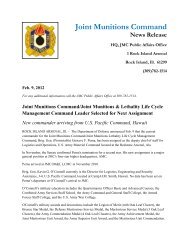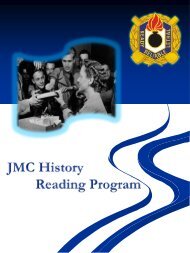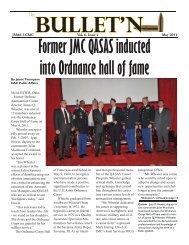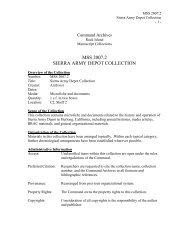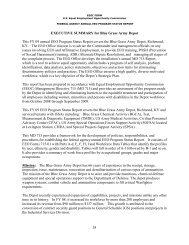History of the Ammunition Industrial Base - JMC - U.S. Army
History of the Ammunition Industrial Base - JMC - U.S. Army
History of the Ammunition Industrial Base - JMC - U.S. Army
You also want an ePaper? Increase the reach of your titles
YUMPU automatically turns print PDFs into web optimized ePapers that Google loves.
planning. Responsibility for procurement <strong>of</strong> military supplies and <strong>the</strong> mobilization <strong>of</strong> material<br />
and industrial organizations were explicitly assigned to <strong>the</strong> Assistant Secretary <strong>of</strong> War. The<br />
Assistant Secretary <strong>of</strong> War <strong>the</strong>n reorganized his <strong>of</strong>fice to include a Planning Branch. This staff<br />
with <strong>the</strong> <strong>Army</strong> and Navy Munitions Board exerted strong influence upon <strong>the</strong> Ordnance<br />
Department‟s planning between world wars. The fact that peacetime mobilization planning was<br />
happening at all was a major accomplishment and step forward for U.S. military readiness. In<br />
<strong>the</strong> 1920s several mobilization plans were finished and modified. Thereafter, new mobilization<br />
plans were generated on average every four years. 18<br />
Despite planning efforts, storage and maintenance <strong>of</strong> ammunition brought great<br />
challenges between WWI and WWII. More money was earmarked for maintenance <strong>of</strong> <strong>the</strong> war<br />
reserve than for any o<strong>the</strong>r purpose. Of <strong>the</strong> total sum, about 60% <strong>of</strong> <strong>the</strong> ammunition budget was<br />
spent annually for ammunition preservation. To maintain a useable War Reserve, periodic<br />
surveillance <strong>of</strong> stocks and careful testing <strong>of</strong> representative lots to detect incipient deterioration<br />
was necessary. <strong>Ammunition</strong> lots that were unserviceable had to be renovated or replaced. In<br />
1926, Public Law 318 authorized exchange <strong>of</strong> deteriorated ammunition for new, but adequate<br />
funding for renovation continued to be hard to obtain. Despite <strong>the</strong> yearly attempts <strong>of</strong> ordnance<br />
spokesmen to explain <strong>the</strong> chemistry <strong>of</strong> ammunition deterioration, Congressmen found <strong>the</strong><br />
argument unconvincing. By 1928, a special program <strong>of</strong> surveillance and renovation was started.<br />
The OD exchanged 4 million pounds <strong>of</strong> unserviceable powder for 350K pounds <strong>of</strong> new flashless<br />
powder and also opened <strong>the</strong> first special renovation plants. Up to WWII, leaders continuously<br />
debated whe<strong>the</strong>r it was better to renovate old stocks than to buy all new ammunition. In October<br />
1938, <strong>the</strong> <strong>Ammunition</strong> Supply Division <strong>of</strong> Field Service estimated it would cost $19 million to<br />
renovate <strong>the</strong> ammunition items required to meet <strong>the</strong> war reserve for <strong>the</strong> Initial Protective Force.<br />
The OD decided to renovate artillery ammunition stocks, but realized future war requirements<br />
would require a large build up <strong>of</strong> <strong>the</strong> base. 19<br />
Throughout <strong>the</strong> 1920s and 1930s research and<br />
modernization lagged. The DuPont Company was<br />
visionary in that <strong>the</strong>y operated <strong>the</strong> nation‟s sole TNT<br />
plant at low production levels in order to maintain <strong>the</strong><br />
equipment, process, and expertise. 20 As ammunition<br />
supplies were expended, <strong>the</strong>re was no major resupply<br />
or modernization effort. At <strong>the</strong> same time,<br />
developments in weapons and doctrine, primarily<br />
abroad, rendered much <strong>of</strong> <strong>the</strong> stored ammunition<br />
obsolete. Poor storage conditions led to <strong>the</strong><br />
deterioration <strong>of</strong> viable modern stocks and<br />
Congressional budgets for ammunition were at a<br />
starvation rate. Thus, <strong>the</strong> ammunition stockpile was<br />
not maintained properly.<br />
Old Hickory Powder Plant – DuPont<br />
bought <strong>the</strong> plant from <strong>the</strong> Government in<br />
1923<br />
Near Nashville, TN<br />
18<br />
Harry Thomson & Peter Roots, US <strong>Army</strong> in World War II The Ordnance Department: Planning Munitions for<br />
War (Center <strong>of</strong> Military <strong>History</strong>, Washington D.C.: 1955), 30, 32, 50.<br />
19 OCH, Vol II, 10-18, 22-24.<br />
20 Berkley R. Lewis and C.B. Rosa, Office <strong>of</strong> <strong>the</strong> Chief <strong>of</strong> Ordnance, <strong>History</strong> <strong>of</strong> <strong>the</strong> Ordnance Department in World<br />
War II, Monograph 4, <strong>Ammunition</strong>, 31 December 1945, 5.<br />
9



